2017 Gurus Forum In Taiwan
The Secrets Of The Hidden Champions

Source:CW
What can we learn from the Hidden Champions? What potential danger is threatening Taiwan in the global competition? See how professor Hermann Simon, elected as the most influential management thinker after Peter Drucker, reveals the secrets of the Hidden Champions in 2017 Gurus Forum in Taiwan.
Views
The Secrets Of The Hidden Champions
By Hermann Simonweb only
Video edited by Sharon Tseng.
This article is an extract from the speech delivered by Professor Hermann Simon in 2017 Gurus Forum in Taipei, Taiwan.
(...)
The Globalia, or the globalized world of the future, will be an enormous driver of growth. In 2030, China, the US, and the EU will form the first global league. In the second global league, ASEAN and Japan will be the biggest economies. So what is required for success in Globalia? Here I identify three factors: innovativeness, manufacturing base and cost competitiveness.
Success Indicator 1: Innovativeness
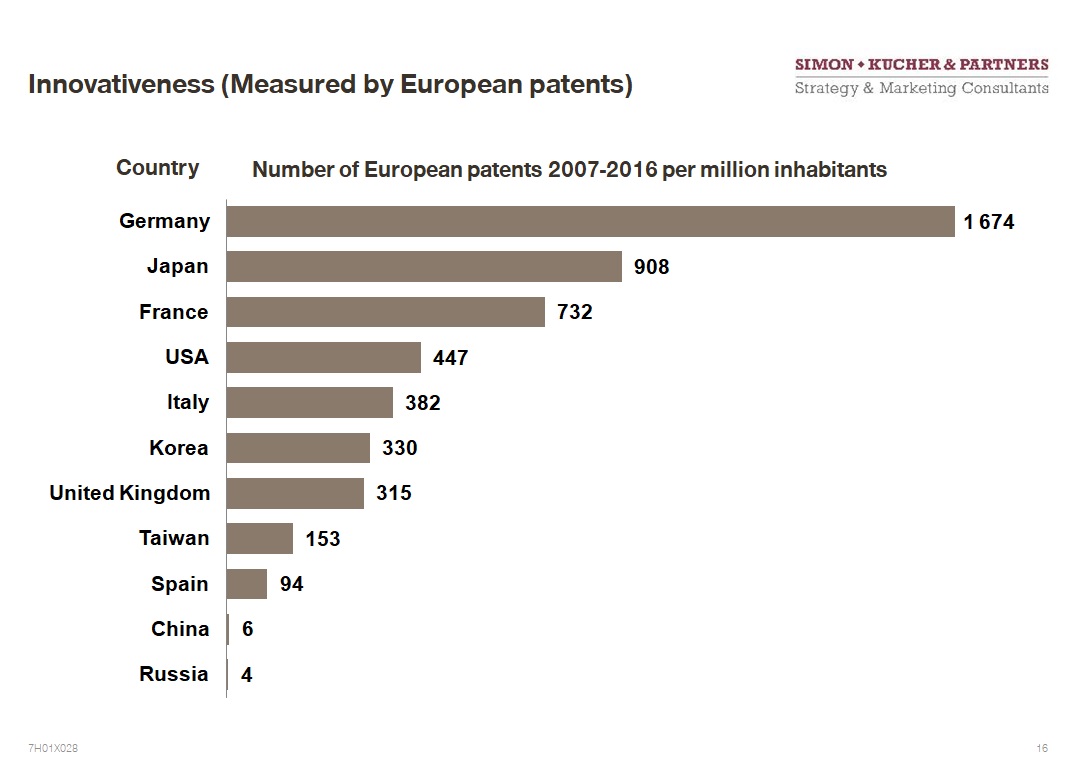 Image: Prof. Hermann Simon
Image: Prof. Hermann Simon
For innovativeness, you see, Germany is far ahead. Especially, if you do a fair comparison, you would compare it with the other European countries. Twice as many as France, four times more than Italy or the UK. But Japan, you see, is also very high in registering European patents. Korea is twice as high as Taiwan. So you could see here, weakness of Taiwanese companies when it comes to protecting your intellectual property and your know-how in the future.
You also see here that, you cannot expect anything from Russia. China, each per capita in comparison for China, is slow. But over the decade, the development of Chinese patents in Europe has grown dramatically, as Russia has been flat for the last 10 years. So this is for 10 years. I always have long-term perspectives.
You also see here, represented by Spain, that Southern Europe here is very weak. It’s the same for Greece and Portugal, so don’t expect anything from Southern Europe. And in Europe, we’re having an increasing diversion between the north and the south. The economic power will lie in German-speaking countries and in Scandinavia, but not in Southern Europe.
Success Indicator 2: Manufacturing Base
Here, I show you the share of manufacturing in gross domestic product in percentage. The horizontal axis shows how much share comes from manufacturing, while the vertical axis suggests the trade balance, which means the exports minus the imports.
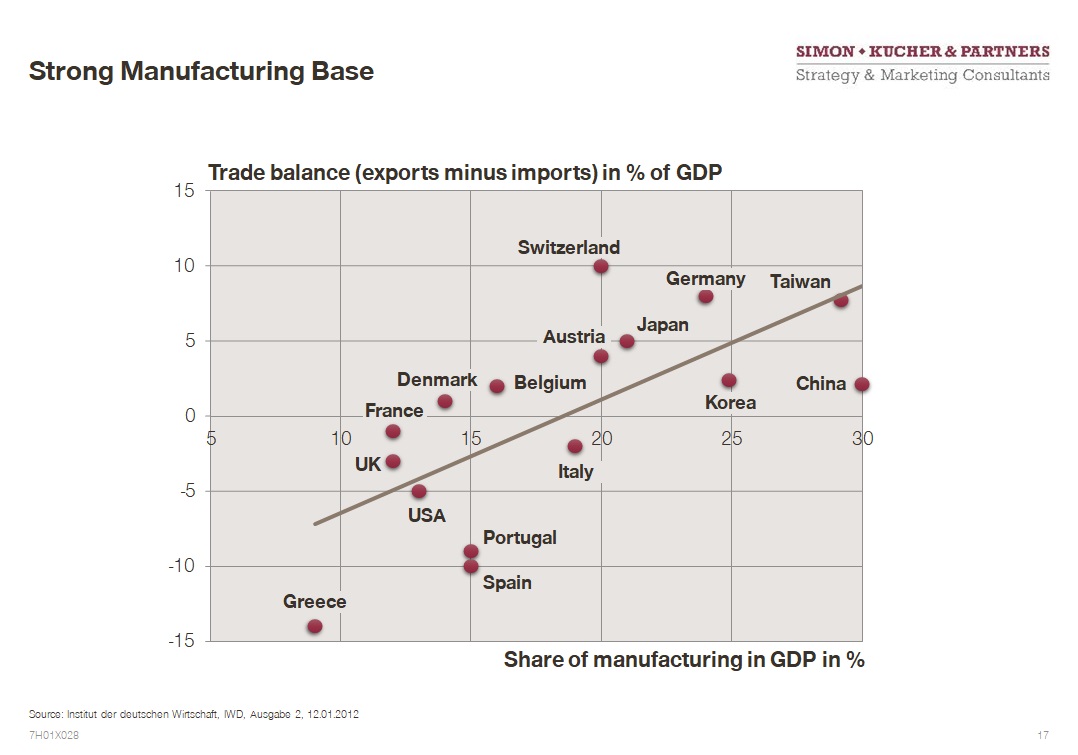 Image: Prof. Hermann Simon
Image: Prof. Hermann Simon
As you may see, there is an almost linear correlation between share of manufacturing and trade balance. So the more you manufacture, the less you have to import, and the more you can export.
Germany is very high. Taiwan is also very high, almost as high as China. Other highly developed countries, France, UK, USA, have only half the percentage of Germany. They have lost their industrial base. And I think it is extremely important to defend your manufacturing base. Why?
When it comes to jobs, manufacturing and services are very different. Think of the US. They have excellent service companies, Starbucks, McDonald's, Hilton, Marriott, you name them. They grow and create jobs. But where do they create jobs? In Mumbai, in Sao Paulo, in Beijing, but not in the whole market.
With manufacturing, you can still create jobs in the whole market, and participate in the growth of emerging countries by exporting. So, as far as the creation and allocation of jobs is concerned, manufacturing and services are very different.
We pay a lot of attention to defend and retain our manufacturing base. Never giving it up. Similar in the US, Trump is now trying to rebuild it, but that is very difficult. That is not only a matter of setting up a plant but you need a whole social infrastructure. You need qualified workers. You need allocation systems. You need suppliers. So rebuilding industry is more than just investment in isolated plants. It needs restructuring of the society.
You have been so far very successful in retaining high manufacturing base. But you have to fight it because I see danger there. You are strong in electronics of course, and mostly commune electronics. But your potential for real improvement, for breakthrough innovations seems to be exhausted. Lots of low-cost productions go to China, or has already gone to China. So defending your manufacturing base will be very important, challenging, and it requires that mid-sized and smaller companies play a key role there. It is not confined to the big guys (large enterprises) in Taiwan.
Success Indicator 3: Cost Competitiveness
The third factor is cost competitiveness. Here I only have comparable data for Europe, which shows you the unit labor costs and how they have developed over the past 15 years in Europe.
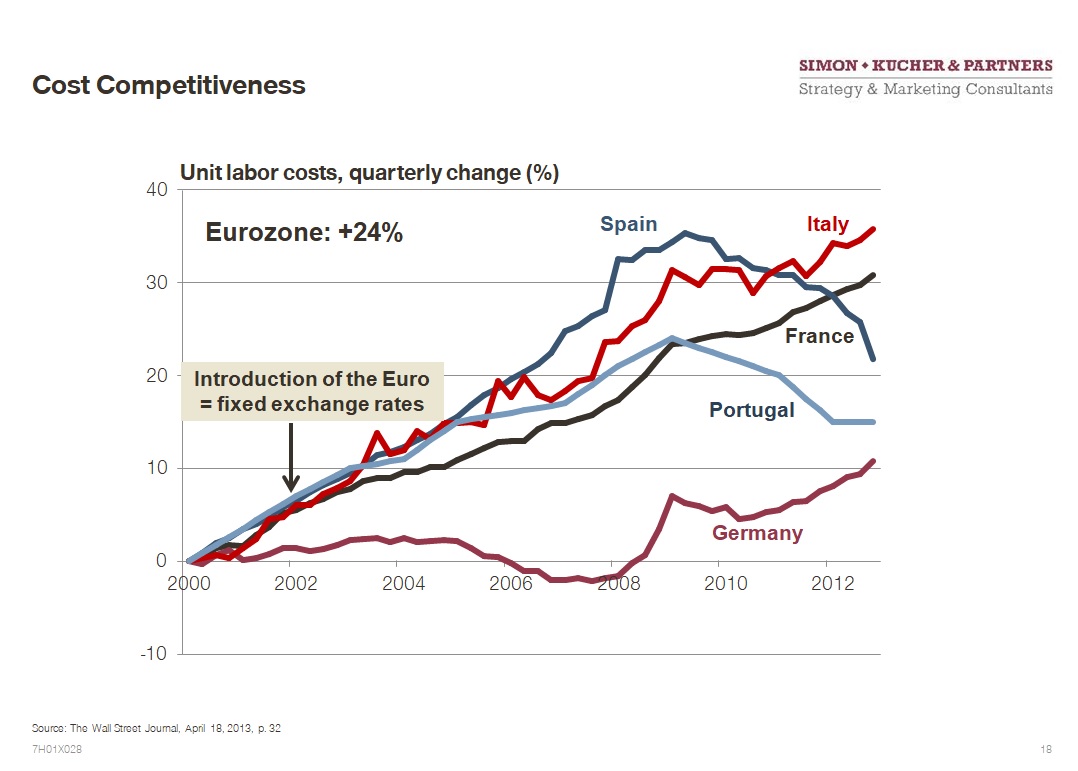 Image: Prof. Hermann Simon
Image: Prof. Hermann Simon
Here you see the explanation for the success of Germany. Unit labor costs measure productivity divided by wages. So if your productivity goes up 5 % but your wages cannot go up 3-4%, you would still reduce unit labor costs. So it's not only wages but it's wages relative to productivity.
Germany has been far below Italy and France. So even if you make innovative, high quality products, you have to remain cost competitive. In Germany, we are obsessed with productivity. BMW says, for example, "We want to increase our productivity every year by 5%." We are obsessed by productivity.
Now, let's come to the business level.
Business success of these individual countries in global competition does not primarily depend on large corporations but on mid-sized world class business like the Hidden Champions.
What Is A Hidden Champion?
A company which is one of the top 3 in its market or number one on its continent, has a revenue of less than $5 billion dollars, and is not well known in general public. Mostly, they are strong mid-sized companies who compete on a global scale.
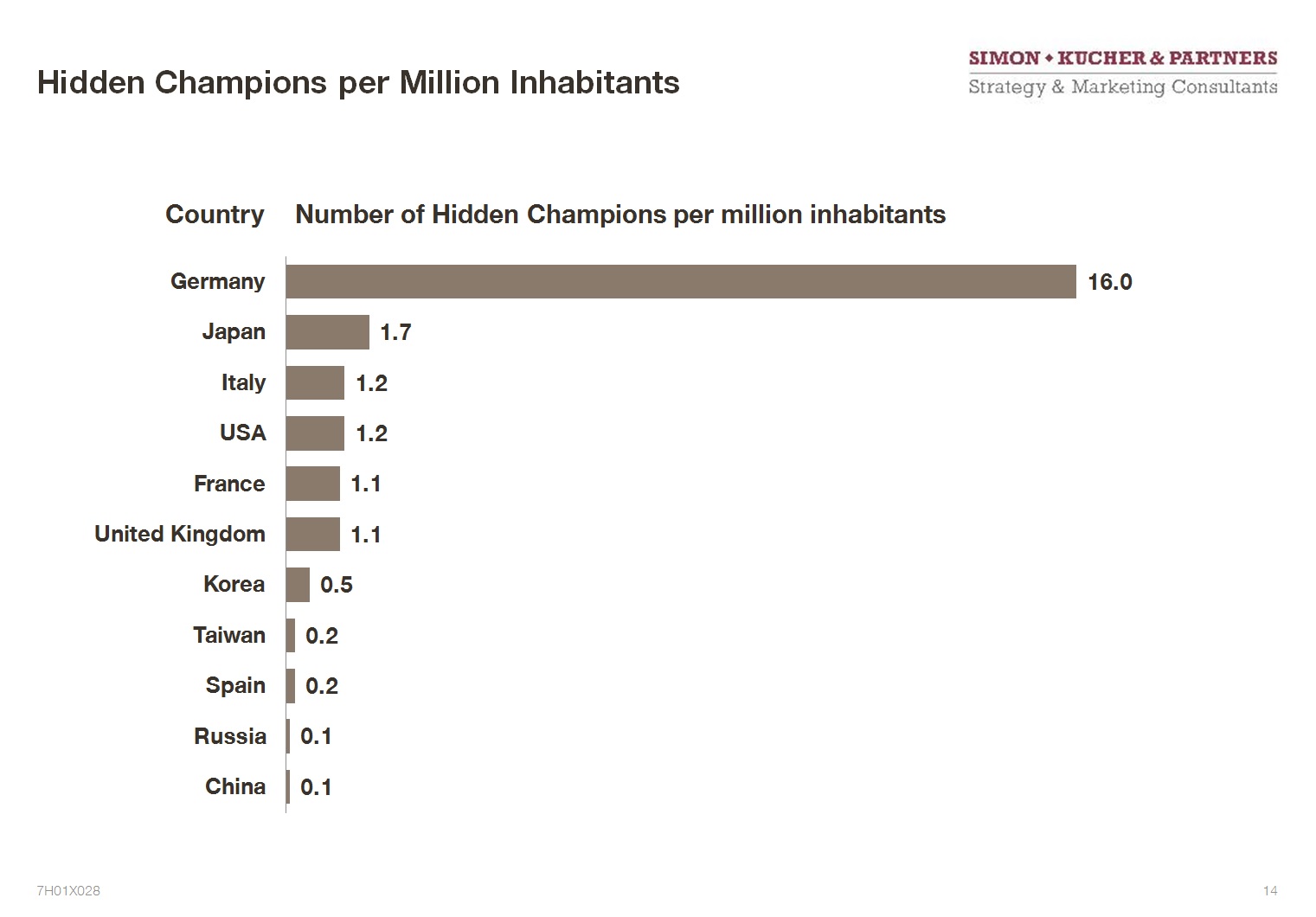 Image: Prof. Hermann Simon
Image: Prof. Hermann Simon
Here I show you the number of Hidden Champions per million inhabitants. And here you see that Germany is way ahead. The number for Taiwan may not be complete. But as an order of magnitude, it can be a little higher, but nothing comes close to Germany. This is the backbone of the German export power, the companies you do not know, unless you are a specialist in your field. So having this strong mid-sized sector, or these Hidden Champions, is extremely important.
Why Are The Hidden Champions So successful? What Can We Learn From Them?
First Observation: Extremely Ambitious Goals
Hidden Champions set extremely ambitious goals for themselves, related to growth and market leadership. There is no substitute for entrepreneurial ambition. Success always begins with highly ambitious goals. They strive for growth and market leadership. To them, market leadership means more than market share. This is the fuel that drives them forward.
Second Observation: Focus Combined With Depth.
Only focus leads to world class. The Hidden Champions are highly focused on their competencies and their markets. Through a deep value chain they create unique products and protect their know-how.
Third Observation: Strategies For Globalization
The Hidden Champions combine focus in product and know-how with global selling and marketing. Globalization is the growth booster for them. They serve the target markets through their own subsidiaries. That brings them close to their customers.
Fourth Observation: Innovation
Look at the chart that is expressed in percentage of revenue.
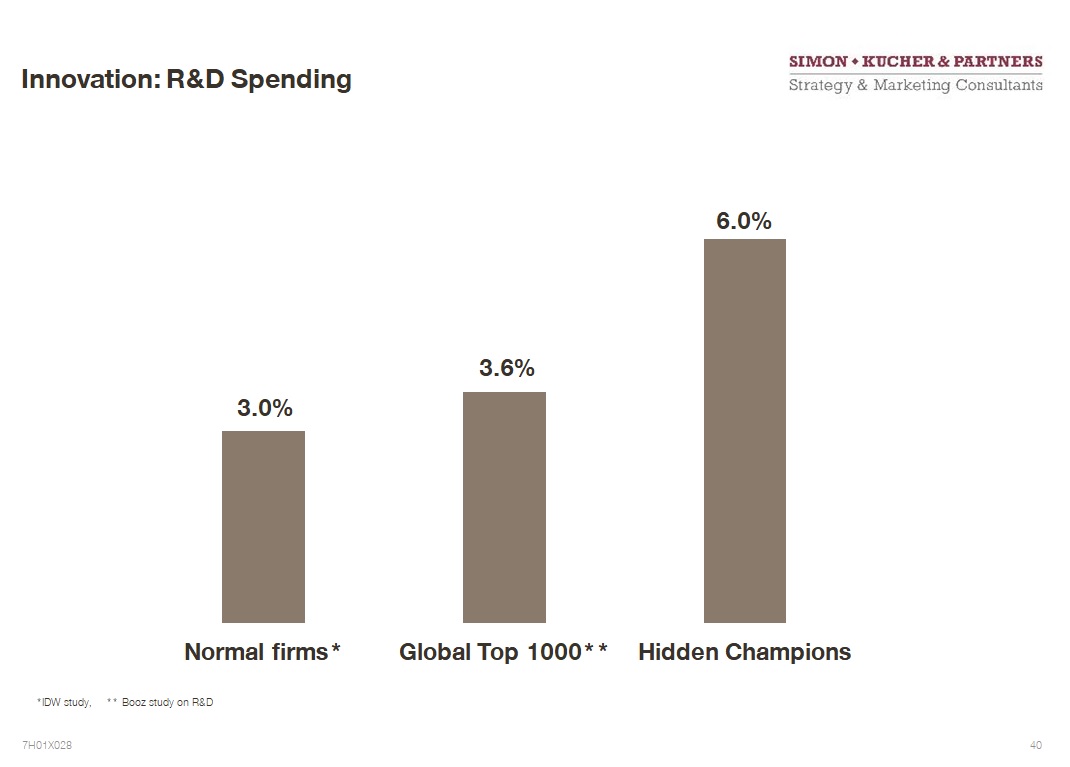 Image: Prof. Hermann Simon
Image: Prof. Hermann Simon
You will not become the market leader by imitating, but only by innovating, and innovation starts from spending money on Research & Development. The Hidden Champions spends about as much as twice the average companies on R&D. Even twice as much as the global top 1000 spenders.
More important, of course, is the outcome. If we compare them with large corporations, the Hidden Champions cover patent-intensive sectors because in some sectors we don't have patents.
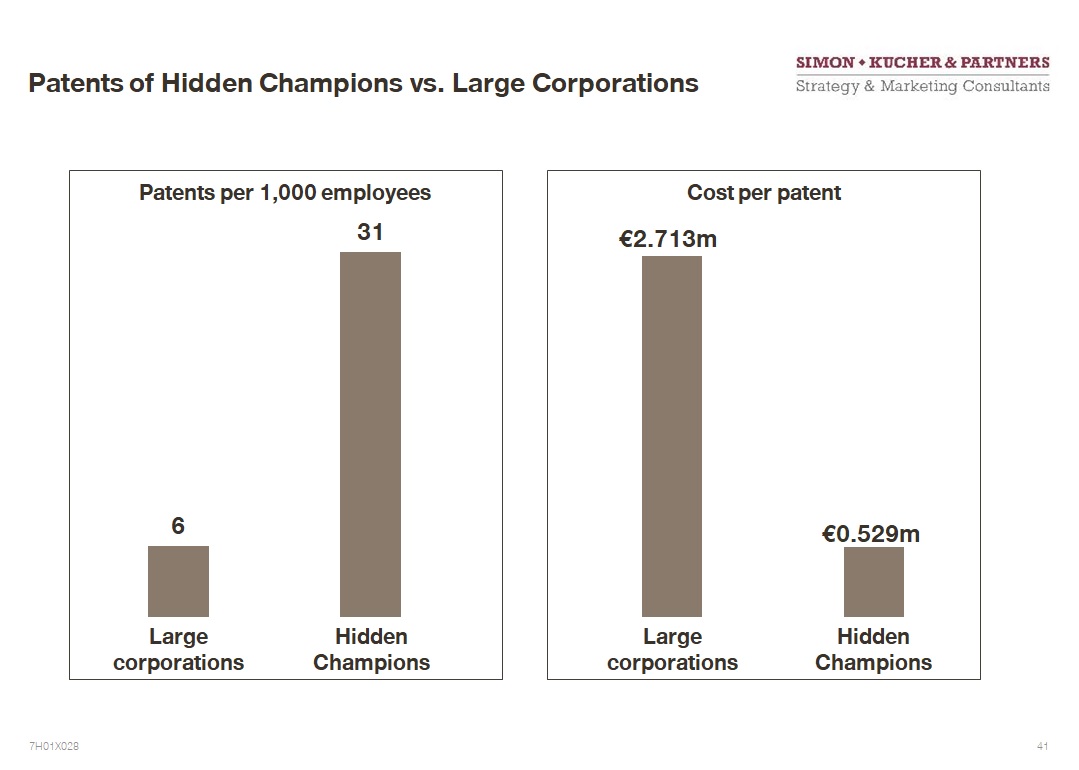 Image: Prof. Hermann Simon
Image: Prof. Hermann Simon
Behind this you may see very different innovation policies. You could say, large corporations throw big budgets at R&D problems, while Hidden Champions employ small teams of deep experts to R&D.
However, the Hidden Champions are massive innovators. The effectiveness of their R&D activities beats that of large companies by a factor of 5. Their innovations are both market- and technology-driven. They are heavily investing into B2B-digitization and strive to become the best in their niche. They hold and defend strong competitive advantages.
(...)
Last Observation: The Internal Strength – Employees And Leaders.
For the employees, there should be more work than heads. If there's too many people, that could be a productivity-killer. Now you have enough employees, high performance cultures, high qualification and low turnover rates to well-train them and retain them, are equally important factors.
For the leaders, they should be authoritarian in the principles, but participative, flexible in the details. The leaders of the Hidden Champions often come young into power. They also have more women in top positions, and have very high continuity, with the average of 20 years for leaders of Hidden Champions, 3 times longer than the average continuity of leaders in large corporations.
I summarized these factors in three circles, easy to memorize. The core is strong leadership with ambitious goals. The inner strength: innovation, depth in what we do, and high performance employees. And to the outer market: focus on a narrow market, remember only focus leads to world class, closeness to customer, very important for innovation, clear competitive advantages and all this in a global orientation. 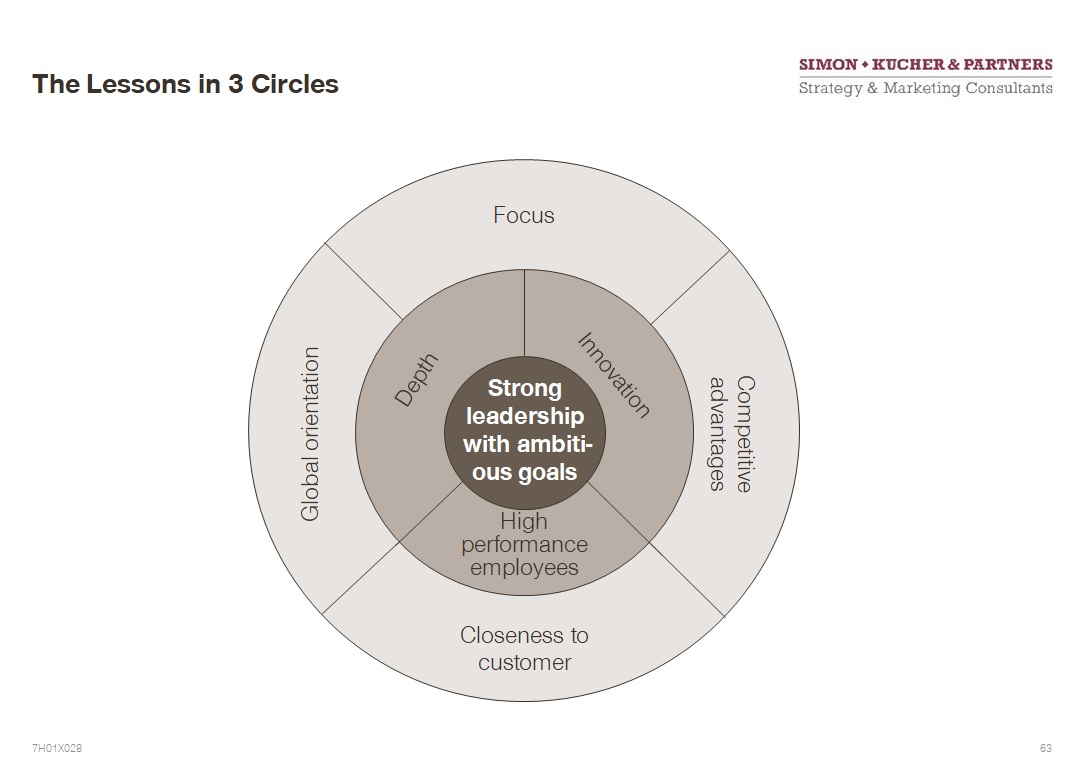 Image: Prof. Hermann Simon
Image: Prof. Hermann Simon
Hermann Simon is Honorary Chairman of Simon-Kucher & Partners. He is an expert in strategy, marketing and pricing. He has an extensive global range of clients. In the German language area he was voted the most influential management thinker after the late Peter Drucker.
Professor Simon has published over 35 books in 26 languages, including the worldwide bestsellers Hidden Champions (Boston 1996, cover story of BusinessWeek in 2004) and Power Pricing (New York 1997), as well as Manage for Profit, Not for Market Share (Boston 2006). His book Hidden Champions of the 21st Century, Success Strategies of Unknown World Market Leaders (New York 2009) investigates the strategies of little known market leaders. His book Confessions of the Pricing Man was published by Springer, New York in October 2015. Price Management, the US version of his leading German textbook, will be published in 2017.
Additional Reading
♦ 2017 Gurus Forum (Chinese)
♦ Hidden Champions Transcend Gloom
♦ ‘Invisible Champion’ Model Taiwan’s Way Out
♦ 'Made in Taiwan' Scores Olympic Gold
♦ Innovation Breathes New Life
♦ Can Taiwan Find an AI Niche?







